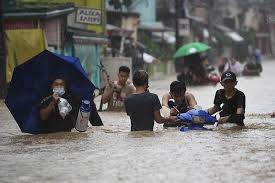Typhoon Vamco (Ulysses) in 2020 brought severe flooding and damage across Luzon, impacting thousands of families and causing widespread devastation.
ADVERTISEMENT

Table of Contents

Typhoon Vamco (Ulysses)
Typhoon Vamco (Ulysses) was notable for being one of the most severe storms to hit the Philippines in 2020, coming just weeks after Super Typhoon Goni. It struck with winds reaching up to 155 km/h (96 mph) and gusts as strong as 255 km/h (158 mph), making multiple landfalls and sweeping across Luzon. The heavy rains triggered widespread flooding, submerging entire communities and displacing nearly 400,000 people. Metro Manila and regions such as Cagayan and Isabela were particularly hard-hit, with the Cagayan River reaching its highest water level in decades, exacerbating the devastation.
The storm’s impact stretched beyond property damage, as it disrupted transportation, power, and communication lines, leading to prolonged blackouts and limited emergency response capabilities. Recovery efforts were challenging due to the scale of the disaster and the ongoing COVID-19 pandemic, which further strained resources. The typhoon’s aftermath highlighted vulnerabilities in the country’s flood management systems and sparked discussions on improving disaster resilience and climate change adaptation.
I. Introduction
Overview of Typhoon Vamco (Ulysses)
Typhoon Vamco, known locally as Ulysses, stands as one of the most devastating tropical cyclones to strike the Philippines in 2020. With its powerful winds and relentless rains, it wreaked havoc across multiple regions, leaving widespread destruction in its wake. This typhoon not only tested the country’s disaster preparedness and response systems but also underscored the vulnerability of communities already grappling with the impacts of climate change. Understanding the full impact of Typhoon Vamco is essential to grasp the scale of the challenges faced by the affected populations and to appreciate the lessons learned for future disaster management.
Context within the 2020 Typhoon Season
The year 2020 was marked by a particularly active typhoon season in the Philippines, with Typhoon Vamco following closely on the heels of Super Typhoon Goni, which had set records as one of the strongest storms to make landfall in the country. The occurrence of these back-to-back typhoons created a compounded crisis, placing immense pressure on local government units, disaster response teams, and emergency services. The dual impact highlighted the limitations of existing infrastructure and disaster response capabilities and emphasized the urgent need for enhanced resilience measures.
II. Path and Characteristics
Landfall and Initial Path
Typhoon Vamco first made landfall in Patnanungan, a town in Quezon Province, on November 11, 2020. As it crossed Luzon, it left a path of severe destruction in its wake, affecting densely populated areas and crucial agricultural regions. The storm moved westward, impacting provinces such as Rizal, Bulacan, Pampanga, and eventually exiting through the West Philippine Sea. The rapid progression across the island meant that many communities had little time to prepare or recover from the storm’s powerful onslaught.
Meteorological Data
With sustained winds of 155 km/h (96 mph) and gusts peaking at 255 km/h (158 mph), Typhoon Vamco was classified as a Category 4-equivalent storm. These wind speeds placed it among the more destructive storms in recent Philippine history. The typhoon’s intensity was a result of favorable conditions over the Philippine Sea, where warm sea surface temperatures provided the energy needed for its rapid intensification. The storm’s wind strength and its ability to carry substantial moisture contributed significantly to the widespread flooding that ensued.
Rainfall and Flood Triggers
The relentless rain brought by Typhoon Vamco resulted in record-breaking precipitation in some areas, overwhelming rivers, dams, and drainage systems. Notably, the Marikina River in Metro Manila reached critical levels, submerging large parts of the city under several feet of water. In the Cagayan Valley, the combined effects of the typhoon’s rainfall and water releases from the Magat Dam led to one of the worst flood events in the region’s history. The scale of the flooding underscored the challenge of managing water resources during extreme weather events.
III. Areas Affected
Regional Impact Overview
The typhoon’s impact was felt most intensely across Luzon, with significant damage recorded in urban centers like Metro Manila and in rural provinces such as Cagayan, Isabela, and Nueva Ecija. Metro Manila experienced widespread flooding, particularly in low-lying areas such as Marikina City, where residents were forced to evacuate as floodwaters rapidly rose. Meanwhile, Cagayan and Isabela faced catastrophic flooding due to the overflow of the Cagayan River, which affected tens of thousands of residents.
Urban and Rural Disparities
The impact of Typhoon Vamco revealed stark differences in how urban and rural communities were affected. In Metro Manila, flooding disrupted public transport, power, and communication lines, while residents in informal settlements faced significant challenges due to inadequate drainage infrastructure. Rural areas, particularly in the Cagayan Valley, faced different issues, including limited access to emergency services and prolonged isolation due to impassable roads. The disparity in recovery times and resource allocation highlighted the need for equitable disaster response planning.
Case Study: Cagayan Valley
The Cagayan Valley region suffered one of the worst flood events in decades, with the Cagayan River rising to historic levels. This flooding not only submerged homes and agricultural lands but also displaced entire communities for weeks. The situation was compounded by delayed response efforts, which drew attention to the logistical challenges of reaching remote areas during extreme weather. This case study emphasizes the importance of a coordinated, timely response and improvements in regional flood management infrastructure.
IV. Human and Economic Impact
Casualties and Human Cost
The typhoon claimed the lives of at least 101 individuals, with more than 200 injured across the affected areas. These fatalities were often the result of rapidly rising floodwaters, landslides, and accidents during rescue operations. The human cost extended beyond the physical loss, as families were left mourning loved ones and dealing with trauma. The stories of resilience and survival that emerged during and after the storm showcased the strength of the Filipino spirit in the face of adversity.
Displacement and Emergency Shelters
Approximately 400,000 people were forced to evacuate their homes due to the flooding and strong winds, many of whom took refuge in overcrowded evacuation centers. The conditions in these shelters often posed additional challenges, such as limited access to food, clean water, and medical care. The concurrent COVID-19 pandemic added another layer of complexity, as health protocols needed to be observed to prevent outbreaks among evacuees.
Economic Damage Assessment
The estimated economic impact of Typhoon Vamco was significant, with losses calculated at around ₱20 billion ($400 million). The agricultural sector, a key part of the economy in regions like Cagayan Valley and Central Luzon, suffered severe damage due to the flooding of rice fields and other crops. Infrastructure damage included destroyed roads, bridges, and residential buildings, further complicating relief efforts and prolonging recovery.
Impact on Livelihoods
Beyond the immediate damage, the storm disrupted the livelihoods of countless individuals, particularly those reliant on agriculture, small businesses, and informal work. Farmers who lost entire harvests faced months of uncertainty, while urban workers struggled with prolonged power outages and a temporary halt to business operations. The ripple effects of these economic disruptions highlighted the need for stronger social safety nets and disaster relief funding.
V. Government and Emergency Response
Initial Government Action
The government, led by the National Disaster Risk Reduction and Management Council (NDRRMC), launched an immediate response to the crisis, deploying rescue teams and coordinating with local government units (LGUs). Despite these efforts, the scale of the disaster revealed gaps in disaster preparedness, particularly in areas that had not fully recovered from previous typhoons.
Emergency Relief and Challenges
Relief operations faced significant challenges due to impassable roads, power outages, and communication breakdowns. Emergency supplies, including food, water, and medicine, were delivered to affected areas, but distribution was often delayed. The overlapping crisis of COVID-19 further strained resources, as health measures had to be implemented to protect evacuees and first responders.
Collaboration with NGOs and International Aid
Non-governmental organizations (NGOs) and foreign governments played crucial roles in supplementing the government’s relief efforts. International aid came in the form of financial assistance, relief goods, and expertise in disaster management. However, coordination between multiple entities proved difficult, highlighting the need for a more streamlined approach to disaster response.
VI. Recovery and Long-Term Effects
Short-Term Recovery Initiatives
In the immediate aftermath of Typhoon Vamco, local and national authorities focused on providing financial assistance, temporary housing, and essential services to displaced families. Relief organizations set up food distribution points and medical camps to assist the injured and vulnerable.
Infrastructure Rebuilding Efforts
The extensive damage to roads, bridges, and residential areas required significant rebuilding efforts. Plans for infrastructure repair and fortification were put into place, but delays in funding and logistical challenges slowed progress. Ensuring resilient infrastructure in flood-prone regions became a priority for future disaster mitigation.
Economic Rebuilding and Community Resilience
Economic recovery was a slow process for many affected by Typhoon Vamco. Government and non-governmental initiatives sought to provide financial aid and job training to help families rebuild their livelihoods. Stories of community resilience emerged, showcasing local efforts to support each other through grassroots initiatives and fundraising.
VII. Lessons Learned and Future Measures
Analysis of Current Disaster Preparedness
The response to Typhoon Vamco revealed significant areas for improvement in the country’s disaster preparedness strategy. While early warning systems were in place, the speed and effectiveness of response efforts were uneven across different regions. This highlighted the need for better-coordinated action plans and clear communication between national and local authorities.
Recommendations for Improved Flood Management
Investments in improved flood management infrastructure became a key takeaway. Suggestions included enhancing river dike systems, building additional reservoirs, and modernizing drainage networks in urban centers to better handle large volumes of water during typhoons.
Climate Change and Typhoon Frequency
Experts pointed out that the increasing intensity and frequency of typhoons were linked to global climate change. This realization fueled calls for stronger climate adaptation measures, such as reforestation, coastal protection projects, and adherence to international climate agreements.
Community-Based Solutions
Community involvement was recognized as an essential component of effective disaster management. Programs aimed at educating residents on disaster preparedness, response drills, and grassroots resilience strategies were highlighted as successful models that should be expanded.
Conclusion
Typhoon Vamco (Ulysses) served as a powerful reminder of the Philippines’ vulnerability to natural disasters and the far-reaching impact such events can have on communities. The storm highlighted the need for stronger infrastructure, improved disaster response systems, and more effective climate adaptation measures. While the resilience and solidarity of the Filipino people were evident in the aftermath, it underscored the importance of proactive strategies to better protect lives and livelihoods in the future. By learning from the experiences of Typhoon Vamco and investing in comprehensive preparedness and recovery plans, the country can build a more resilient and adaptive society ready to face future challenges.
Disclaimer
This content is provided for informational purposes only and should not be considered as professional advice. While every effort has been made to ensure the accuracy and reliability of the information, the author and publisher do not assume any responsibility for errors, omissions, or any actions taken based on this content. Readers are encouraged to consult with relevant experts or authorities for specific guidance related to disaster preparedness, response, and recovery.
About Authors
Kween Yulo is a seasoned SEO writer with 15 years of experience, specializing in diverse niches across the digital landscape. Her expertise spans various industries, including gaming, e-commerce, finance, travel, and lifestyle. Known for crafting engaging, optimized content, Kween’s writing is tailored to boost search rankings and enhance user engagement. Her deep understanding of SEO trends, keyword strategies, and audience behavior has made her a trusted content creator for businesses seeking to strengthen their online presence. Kween’s versatility and dedication to quality make her an asset in any digital content strategy.


